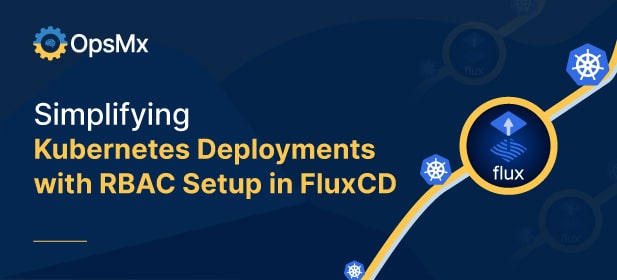Introduction:
In the world of Kubernetes, managing deployments can be complex, especially as the number of applications and clusters grows. OpsMx introduces FluxCD, a powerful GitOps tool designed to automate deployments and manage Kubernetes resources. One key aspect of securing FluxCD deployments is Role-Based Access Control (RBAC). RBAC ensures that only authorized users have access to specific resources within a Kubernetes cluster. In this guide, we will delve into setting up RBAC for FluxCD, making your deployments more secure and manageable.
Understanding RBAC in Kubernetes:
RBAC in Kubernetes allows administrators to define roles, role bindings, and service accounts to control access to cluster resources. Roles define a set of permissions, while role bindings associate these roles with specific users, groups, or service accounts. Service accounts are used by applications and other processes running in the cluster to authenticate with the Kubernetes API server.
Why RBAC Matters for FluxCD:
FluxCD operates by continuously monitoring a Git repository for changes to Kubernetes manifests and automatically applying those changes to the cluster. However, granting FluxCD unrestricted access to the cluster can pose security risks. By implementing RBAC, you can limit FluxCD’s permissions to only the resources it needs, reducing the potential attack surface and ensuring compliance with security policies.
Setting Up RBAC for FluxCD:
Here’s a step-by-step guide to setting up RBAC for FluxCD:
1. Create a Service Account:
Start by creating a dedicated service account for FluxCD. This service account will represent FluxCD’s identity within the cluster.
apiVersion: v1
kind: ServiceAccount
metadata:
name: fluxcd
namespace: flux-system
2. Define a Role:
Next, define a role that grants FluxCD permissions to manage resources within its namespace. FluxCD typically requires permissions to create, update, and delete resources like deployments, services, and ingresses.
apiVersion: rbac.authorization.k8s.io/v1
kind: Role
metadata:
name: fluxcd-role
namespace: flux-system
rules:
- apiGroups: [""]
resources: ["deployments", "services", "configmaps", "secrets"]
verbs: ["get", "list", "watch", "create", "update", "patch", "delete"]
3. **Create a Role Binding**:
Now, bind the role to the FluxCD service account, specifying the appropriate namespace.
apiVersion: rbac.authorization.k8s.io/v1
kind: RoleBinding
metadata:
name: fluxcd-role-binding
namespace: flux-system
subjects:
- kind: ServiceAccount
name: fluxcd
namespace: flux-system
roleRef:
kind: Role
name: fluxcd-role
apiGroup: rbac.authorization.k8s.io
4. **Apply the Configuration**:
Apply the YAML manifest to your Kubernetes cluster using the command `kubectl apply -f <filename>`.
Conclusion:
By following these steps, you have successfully configured RBAC for FluxCD, enhancing the security of your Kubernetes deployments. RBAC ensures that FluxCD has the necessary permissions to perform its tasks without exposing your cluster to unnecessary risks. As you continue to leverage FluxCD for GitOps automation, maintaining a robust RBAC setup will be essential for securing your Kubernetes infrastructure.
About OpsMx
OpsMx is a leading innovator and thought leader in the Continuous Delivery space. OpsMx’s Solution for Flux helps DevOps teams manage their Flux deployments at scale.
Talk to OpsMx’s FluxCD experts about any questions that you may have around Flux, GitOps-style deployments, Kubernetes, or DevSecOps. Our services enable the largest and most innovative companies to optimize their (GitOps) delivery pipelines.

0 Comments